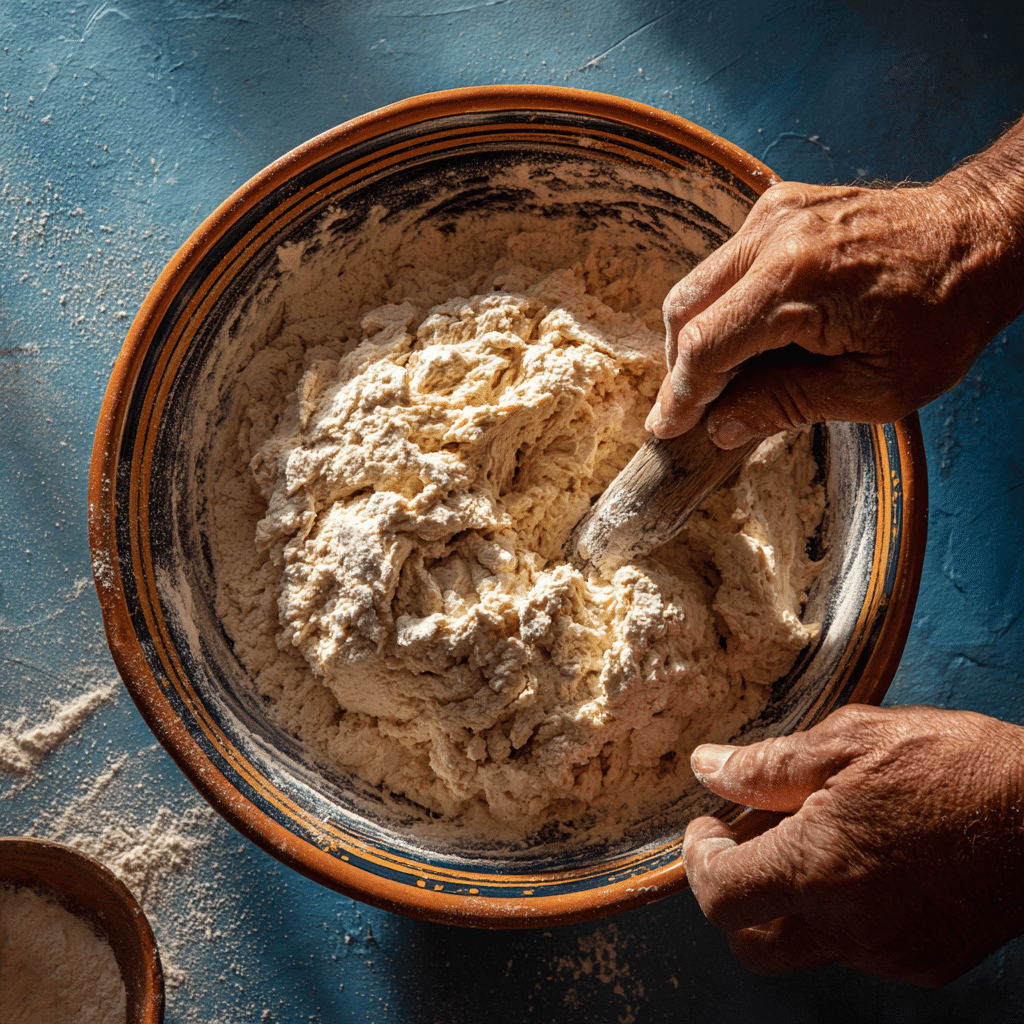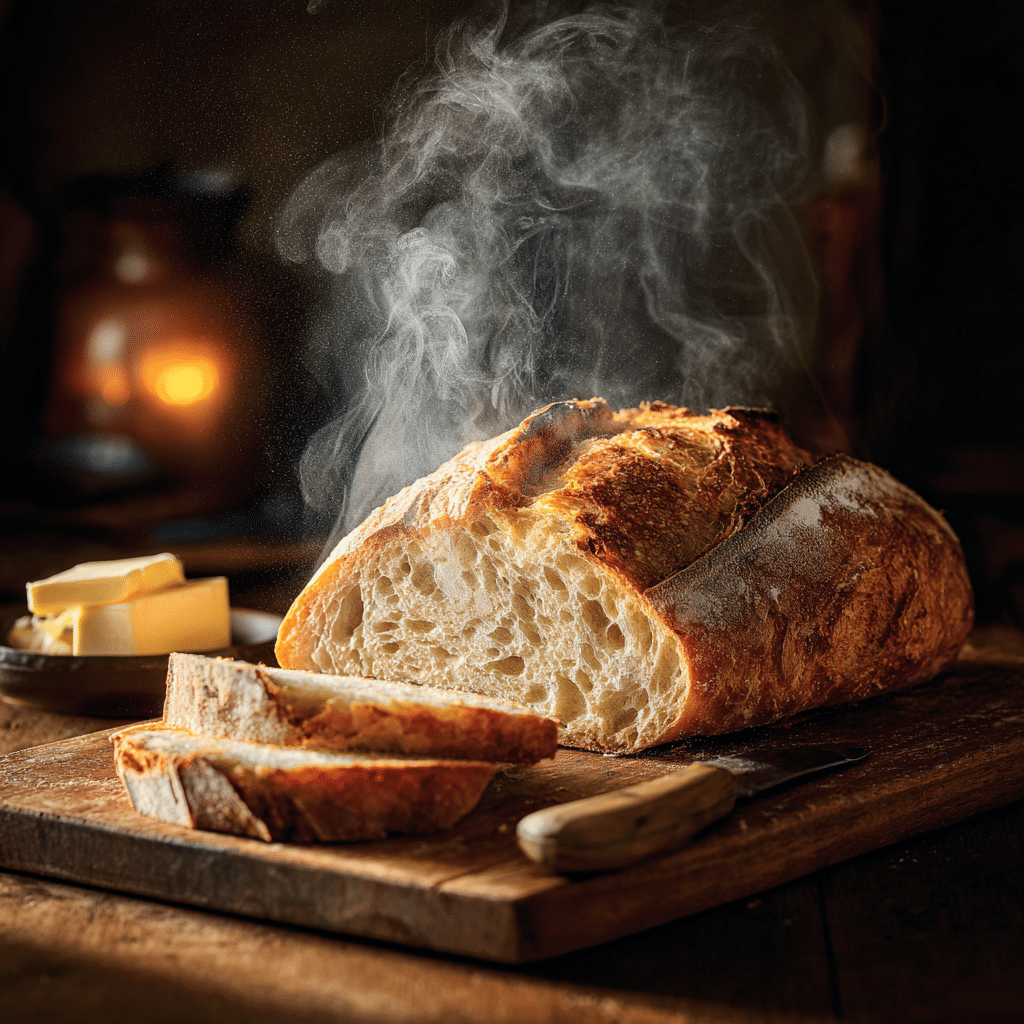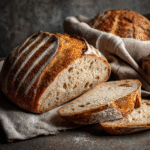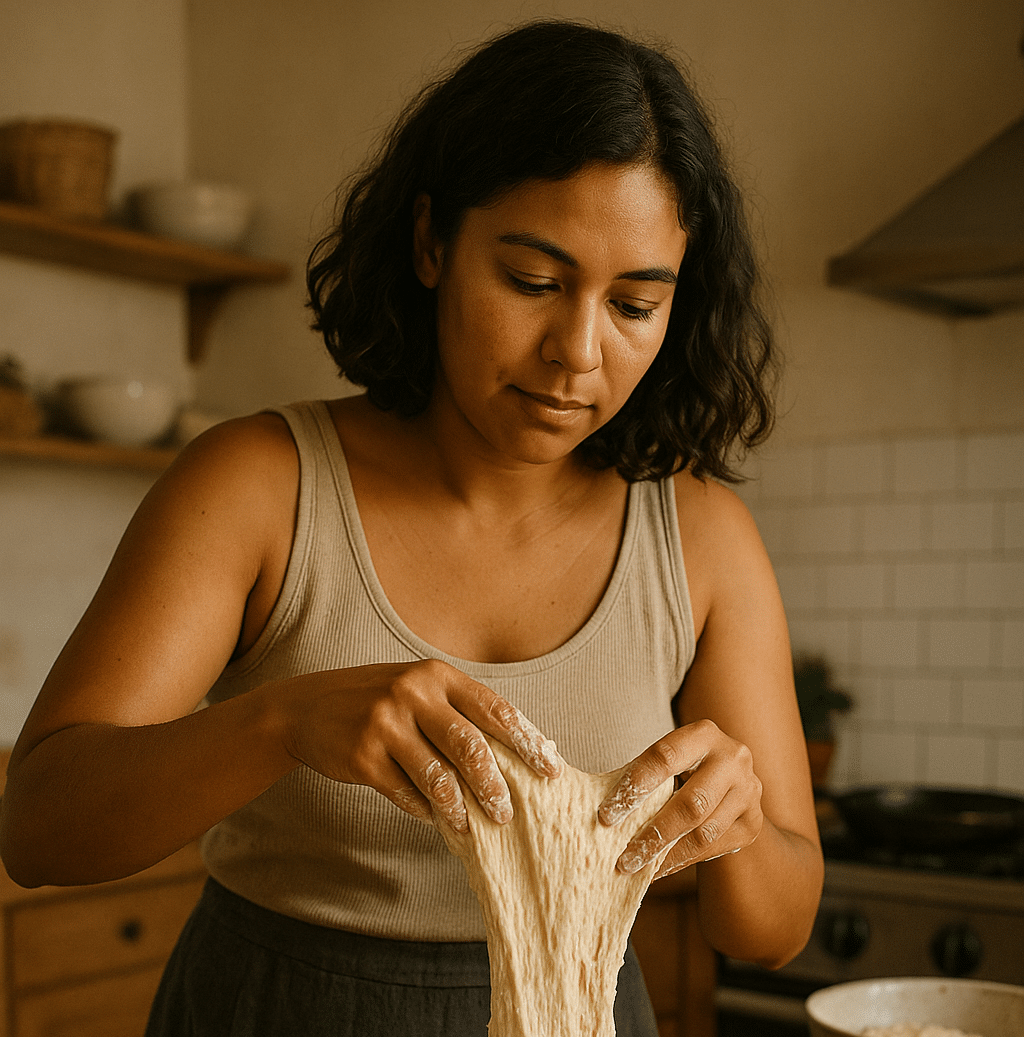Baking sourdough without a starter might sound like a contradiction—but it’s not only possible, it’s wonderfully satisfying. In this article, you’ll learn how to make sourdough bread without a starter, whether you’re out of discard or just beginning your journey. We’ll explore foolproof methods, natural alternatives, and surprising shortcuts. Plus, we’ll answer your most pressing questions—like whether a three-ingredient sourdough is the real deal.
Let’s begin with something a little personal.
Why I First Baked Sourdough Without a Starter
Finding the “starter” within
When I first started baking, I believed sourdough starters were sacred—tiny jars of mystery passed down or babied for months. But one winter afternoon, after mistakenly tossing my starter thinking it had gone moldy, I stood in my kitchen with no backup, a yearning for fresh bread, and a little bit of panic.
Could I still make sourdough without a starter?
I decided to experiment—and what came out of the oven changed everything. That loaf, rustic and golden, cracked open with a sour tang I hadn’t expected. It was alive in its own right. And that’s when I realized: the soul of sourdough isn’t just in the starter—it’s in the method, the patience, the fermentation. That’s the magic. And yes, it can be made without a traditional starter.
What is sourdough bread without a starter?
Sourdough bread without a starter relies on spontaneous fermentation or quick fermenting agents like yogurt, lemon juice, or vinegar combined with flour and water. Rather than using a mature culture, you create the conditions for natural wild yeasts or mimic the tang through acidic balance.
One clever method I now love is using a blend of flour, water, and acidic ingredients, then allowing it to ferment briefly. It’s similar in flavor to long-fermented doughs—and perfect for those who want sourdough results without babysitting a starter for weeks.
A great example of this method is shared in this one-bowl no starter sourdough recipe, which uses pantry ingredients and just a bit of patience.
Why you might skip the starter (and still succeed)
There are lots of reasons to bake this way:
- You’re a beginner and unsure about maintaining a live starter.
- You accidentally tossed yours (like me).
- You want sourdough flavor now—not in 7 days.
These days, recipes like this easy no-starter sourdough are becoming more popular with folks who want the joy of sourdough baking but without the daily feedings. It’s a method that invites everyone to the table.
Sourdough isn’t just for experts anymore
One of my favorite things about sourdough is how it adapts. You don’t have to follow strict rules. In fact, some of the best loaves I’ve baked came from wild attempts—like recreating flavor by combining yogurt, lemon juice, and a long rest time. It’s similar to how Amish sourdough recipes develop their flavor from sweet fermentations rather than traditional tang.
How to Make Sourdough Bread Without a Starter – What You Need Instead
Yes, you can fake the funk (and flavor)
If you’re wondering how to make sourdough bread without a starter, the good news is: it’s entirely doable and surprisingly rewarding. Instead of using a mature starter, we recreate similar flavor and fermentation with everyday pantry ingredients and a little patience.
What replaces the sourdough starter?
When learning how to make sourdough bread without a starter, you’ll want to use ingredients that either mimic the acidity or encourage spontaneous fermentation. Here are some effective options:
- Yogurt or buttermilk – Cultured dairy adds a pleasant tang and supports natural yeast activity.
- Apple cider vinegar or lemon juice – Just 1–2 teaspoons introduces acidity that simulates the starter’s sour profile.
- A long room-temperature rest – Letting your dough sit for 10–12 hours encourages wild yeast and gluten development.
- Optional yeast “boost” – A pinch of commercial yeast can help beginners nail down how to make sourdough bread without a starter while still getting that crusty finish.
These substitutions work together beautifully in recipes like this no-starter sourdough, where a long rest does all the heavy lifting.
What about 3-ingredient sourdough bread?
A common myth about how to make sourdough bread without a starter is that you need complex ingredients. In truth, many bakers succeed with just flour, water, and salt. These three ingredients, when fermented slowly, yield a rustic loaf full of natural flavor and chewy texture.
To make it work, timing and temperature matter more than tools. If you want to test your skills, spelt sourdough or pretzel-style bread are perfect beginner options.
Step-by-Step – How to Make Sourdough Bread Without a Starter

Simple method, rustic results
Now that you know the ingredients and fermentation tricks, let’s walk through exactly how to make sourdough bread without a starter from start to finish. This method is beginner-friendly, no-knead, and delivers the real sourdough experience—without the long-term maintenance of a starter.
Step 1: Mix your dough and let it rest
You’ll start with a basic formula:
- 500g bread flour
- 375g warm water (about 75% hydration)
- 1 tsp sea salt
- 2 tsp yogurt or 1 tsp apple cider vinegar (or lemon juice)
- Optional: ⅛ tsp instant yeast (if you want a bit more lift)
Mix everything in a large bowl until just combined. The dough will look shaggy and sticky. Cover it with a towel or plastic wrap and let it rest at room temperature for 8 to 12 hours.
This long rest allows subtle fermentation to occur, even without a starter. This method is central to every variation of how to make sourdough bread without a starter, including options like mini sourdough loaves that ferment quickly.
Step 2: Fold and shape your dough
Once the dough has rested, it should be puffed, slightly bubbly, and easier to handle. Lightly flour your hands and perform a few stretch-and-folds to build structure.
Shape into a round or oval and place it in a well-floured banneton, colander, or bowl lined with a cloth.
Cover again and let it rise for 1–2 more hours at room temperature. Don’t skip this—final proofing is key to mastering how to make sourdough bread without a starter that still rises and scores well.
Step 3: Preheat and bake
Preheat your oven to 450°F (230°C) with a Dutch oven inside. Once ready, transfer your dough onto parchment, score it, and place it in the hot Dutch oven. Cover and bake for 25 minutes. Then remove the lid and bake another 20–25 minutes until deep golden brown.
The result? A crispy crust, chewy crumb, and authentic tang—even without traditional culture.
Baker’s tip: Want an extra punch of flavor without a starter? Let the dough rest in the fridge overnight after shaping. This cold proof adds complexity, much like the traditional sourdough process.
If you’re ever unsure whether your fermentation is going well, refer to signs in this helpful starter troubleshooting guide. Even if you’re not using a starter, the signs of good fermentation are the same—bubbles, lightness, and a gentle sour aroma.
Tips & Troubleshooting – How to Make Sourdough Bread Without a Starter Successfully
Read this before your first bake
Learning how to make sourdough bread without a starter is exciting, but it does come with questions—especially when you’re flying starter-free. In this final section, I’ll walk you through the most common mistakes, how to fix them, and share a few trusted shortcuts to help your bread rise, even without wild yeast in a jar.
Common Mistakes When Going Starter-Free
- Using cold ingredients
Fermentation needs warmth to thrive. Always use room-temperature or slightly warm water to give your dough a proper head start. - Skipping the long fermentation
The biggest mistake new bakers make is rushing. If you want to understand how to make sourdough bread without a starter, know this: time is your new starter. Let the dough rest 10–12 hours, and don’t cut corners. - Too much acid
While lemon juice or vinegar helps mimic tang, too much will kill any natural yeast activity. Stick to 1–2 teaspoons max per loaf.
If your dough didn’t rise, consider trying a hybrid method like in Zourdough’s guide—a playful, one-time fermentation using fruit, fermented juice, or even mashed apple to naturally attract wild yeast.
Pro Tips to Improve Every Bake
- Cold proof = extra flavor
After shaping your dough, let it rest in the fridge overnight. This mimics traditional sourdough flavor and tightens the crumb. - Use a Dutch oven
For crisp crust and consistent rise, baking inside a Dutch oven traps steam—creating the signature pop and ear that sourdough lovers crave. - Watch the dough, not the clock
Because ambient temperatures vary, always go by feel. A properly proofed dough will jiggle slightly and feel airy when poked. - Want more rise? Add a pinch of yeast
Still learning how to make sourdough bread without a starter but need a confidence boost? A tiny bit of instant yeast doesn’t disqualify your bake—it just helps the first few times while flavor builds from acid and time.
Try it with different flours
If you love experimenting, this is the perfect method to test whole grain, rye, or spelt. The forgiving nature of this no-starter style is ideal for recipes like the spelt sourdough that delivers every time.
Even sweet and savory versions like sourdough pretzel bread can be made using this method. It’s not about what you’re missing (the starter)—it’s about what you’re creating.
FAQs About How to Make Sourdough Bread Without a Starter
Can sourdough bread be made without a starter?
Yes, sourdough bread can absolutely be made without a traditional starter. The key is to create similar conditions through slow fermentation, acid additions like yogurt or vinegar, and time. Using these methods, you can mimic both the flavor and texture of sourdough.
Can you make sourdough without feeding the starter?
Yes, and it’s one of the best parts of learning how to make sourdough bread without a starter—you skip the maintenance entirely. No daily feedings, no discard. Instead, you prepare a fresh mixture and allow it to ferment just once before baking.
Can you make your own sourdough starter?
If you prefer to build one over time, absolutely. You simply mix flour and water and let it ferment over several days. But if you’re not ready to commit to that process, this guide shows you how to make sourdough bread without a starter using ingredients you already have.
What is the 3-ingredient sourdough?
This usually refers to sourdough made with flour, water, and salt. The “starter” in this case is built through time and natural yeast from your environment. You’ll let the mixture rest long enough to develop fermentation and tang—like in this no-starter sourdough recipe.
Conclusion: Start Baking Without the Starter

If you’ve ever peeked into a starter jar wondering if it’s “alive,” you’re not alone. I’ve been there. But now you know how to make sourdough bread without a starter, with confidence and curiosity.
All you need is a bit of flour, some patience, and the willingness to let nature do its quiet work. Whether you’re short on time, starter, or just looking for a simplified method, this approach brings the crackle, chew, and soul of sourdough into reach—no feeding schedule required.
So go ahead—mix a bowl tonight, rest it, and bake tomorrow. Your starter-free sourdough story is just beginning.
For More Sourdough Recipes Follow me on Pinterest
Print
How to Make Sourdough Bread Without a Starter (Yes, Really!)
- Total Time: 14 hours
- Yield: 1 loaf
- Diet: Vegetarian
Description
Learn how to make sourdough bread without a starter using a simple mix of flour, water, salt, and a natural acidic boost. Perfect for beginners who want a rustic loaf without maintaining a sourdough starter.
Ingredients
500g bread flour
375g warm water
1 tsp sea salt
2 tsp yogurt or 1 tsp apple cider vinegar
Optional: ⅛ tsp instant yeast
Instructions
1. In a large bowl, mix all ingredients until a shaggy dough forms.
2. Cover and rest at room temperature for 8–12 hours.
3. Stretch and fold dough a few times to build strength.
4. Shape the dough and place it in a floured proofing bowl.
5. Let rise again for 1–2 hours.
6. Preheat oven to 450°F with a Dutch oven inside.
7. Score the dough and bake covered for 25 minutes.
8. Remove lid and bake 20–25 more minutes until golden brown.
Notes
For added flavor, cold-proof the shaped dough in the fridge overnight.
Use only room temperature water to help fermentation.
Optional yeast ensures better rise on the first few tries.
- Prep Time: 10 minutes
- Cook Time: 50 minutes
- Category: Bread
- Method: Baking
- Cuisine: American





